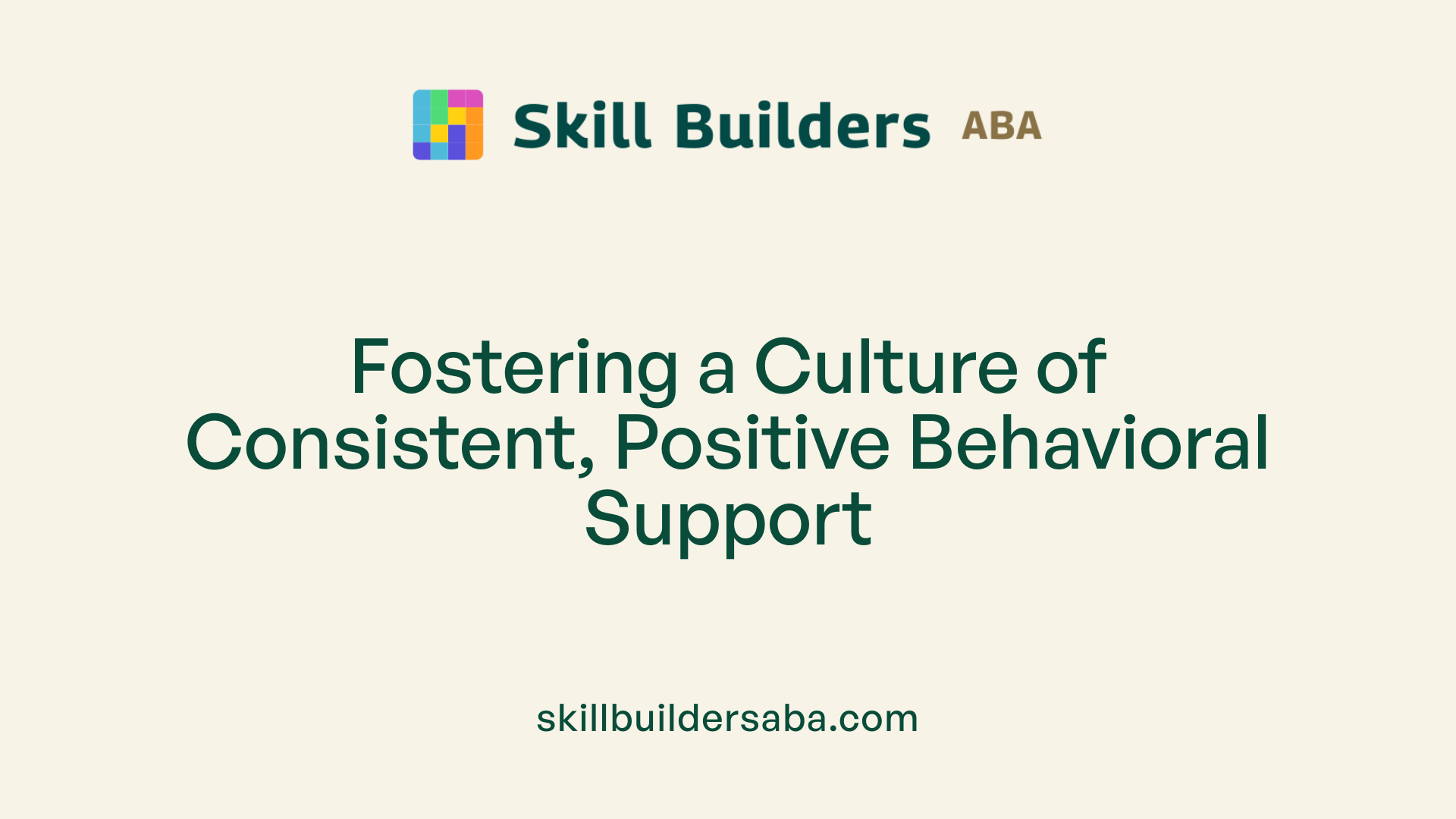How to reduce noncompliance using positive strategies
Transforming Compliance: Effective Positive Strategies for Behavioral Improvements

Understanding Noncompliance and Its Challenges
Noncompliance is a common challenge in behavioral management across various settings, from classrooms to healthcare environments. It involves a person's deliberate refusal to follow instructions or adhere to rules, which can hinder progress and create safety concerns. Addressing noncompliance effectively requires a shift from punitive measures to positive, proactive strategies that foster cooperation and trust. This article explores evidence-based approaches to enhance compliance by utilizing positive reinforcement, building relationships, and implementing behavioral interventions grounded in empathy and consistency.
Foundations of Positive Behavioral Management

Principles of positive reinforcement
Positive reinforcement is a fundamental component of behavioral management that encourages children to repeat desirable behaviors by rewarding them immediately and consistently. When a child is praised for appropriate behavior or given a tangible reward, the likelihood of that behavior recurring increases. This approach not only promotes compliance but also helps build a child's confidence and motivation. Using specific, descriptive praise — such as “Great job following instructions” — helps children understand exactly what behavior is appreciated.
Effective reinforcement strategies involve timely feedback, meaning praise or rewards are given right after the desired behavior occurs. This immediacy helps establish a clear connection between actions and consequences, making it easier for children to learn what is expected.
Importance of consistency and immediacy in feedback
Consistency is vital to maintaining behavioral boundaries and encouraging compliance. When caregivers and teachers apply rules fairly and predictably, children know what to expect and understand the standards they are expected to meet. This consistency extends to employing consequences or rewards without delay, which reinforces the learning process.
Immediate feedback, especially in the form of praise for positive behavior, reinforces the child’s understanding that their actions have direct, positive outcomes. For example, giving a child a high-five or verbal praise immediately after they complete a task correctly can significantly enhance their motivation to continue demonstrating that behavior.
Building trust through follow-through
Follow-through is essential in establishing and maintaining trust in any behavioral management strategy. When caregivers or teachers say they will deliver a consequence or reward, it is crucial to do so consistently. Following through on promises or consequences shows children that adults are reliable and fair, fostering a secure environment where children feel valued and understood.
Maintaining this consistency over time leads to a stable and trusting relationship, which is critical in managing compliance. Children learn that their efforts are recognized and that boundaries are predictable, reducing anxiety and defiance.
| Strategy | Description | Benefits |
|---|---|---|
| Positive reinforcement | Reward appropriate behaviors immediately and frequently | Increases likelihood of repeat behaviors |
| Consistent feedback | Apply rules and consequences fairly and predictably | Builds security and understanding |
| Follow-through on promises | Complete agreed-upon actions, rewards, or consequences when stated | Strengthens trust and reliability |
| Use of praise | Provide specific, descriptive praise for accomplishments | Boosts motivation and self-esteem |
| Timely and clear communication | Convey instructions and feedback plainly and promptly | Enhances comprehension and compliance |
These strategies, when integrated thoughtfully, create a positive environment conducive to learning and cooperative behavior. They emphasize respect, predictability, and support, which are fundamental to effective behavioral management.
Utilizing Immediate and Frequent Praise

What are effective strategies to manage and improve compliance using positive reinforcement techniques?
Effective management of compliance through positive reinforcement involves several well-established strategies. First, providing clear and brief instructions ensures that the individual understands what is expected, reducing confusion and resistance. Delivering praise immediately after the desired behavior occurs is crucial, as it helps the individual associate their actions with positive feedback.
Verbal praise, such as saying “Great job” or “Well done,” should be enthusiastic and specific about what was done correctly. Tangible rewards, like stickers or tokens, can also reinforce desirable behaviors, especially in children. Collaboration with behavior specialists to create behavior intervention plans—often called BIPs—can integrate reinforcement contingencies tailored to individual needs.
Using demonstrations, role-plays, and modeling can further reinforce positive behaviors by providing clear examples of expected actions. Frequent performance feedback, either verbally or through charts, helps individuals recognize progress and maintains motivation. Collecting data on behavior and reinforcement effectiveness allows for ongoing adjustments, ensuring strategies remain effective and meaningful.
In the classroom or therapeutic settings, reinforcing compliance with these techniques creates a consistent, nurturing environment that promotes engaging and sustaining positive behaviors.
How does positive reinforcement contribute to long-term compliance in behavioral settings?
Positive reinforcement plays a vital role in establishing and maintaining long-term compliance. When desirable behaviors are rewarded reliably and immediately, they become more ingrained as habits. This consistent feedback loop helps individuals understand which behaviors are valued, increasing their likelihood of continued cooperation.
As behaviors become habitual, the need for external rewards diminishes, fostering intrinsic motivation. Over time, such reinforcement strategies support self-regulation skills and help build self-esteem. They also promote positive relationships between caregivers, educators, or healthcare providers and the individual.
This supportive environment reduces reliance on punitive measures, which can be counterproductive or diminish trust. Instead, positive reinforcement nurtures a culture of cooperation, making compliance more sustainable. Ultimately, this approach encourages individuals to internalize the value of positive behaviors, leading to consistent compliance across various settings and over the long term.
Pre-correction and Behavioral Momentum

What are some proactive, positive interventions to reduce defiance and promote compliance?
Implementing proactive and positive strategies in the classroom is essential for reducing defiance and encouraging compliance. These methods are grounded in evidence-based frameworks like Positive Behavioral Interventions and Supports (PBIS), which focus on teaching and reinforcing desired behaviors. Teachers can establish clear expectations and routines so students understand what is expected of them at all times.
Consistent responding to behaviors and the use of positive reinforcement, such as verbal praise or tangible rewards, help create a supportive environment that motivates students to comply. Building strong relationships through constructive communication, culturally responsive practices, and engaging families and community members also plays a vital role.
Furthermore, regularly collecting data and participating in ongoing professional development ensures these strategies remain effective and are tailored to individual student needs. Overall, these preventive measures foster a nurturing classroom climate where positive behaviors are cultivated and noncompliance is minimized.
What is pre-correction, and how does it aid in reducing non-compliance?
Pre-correction is a proactive technique that involves anticipating potential non-compliance or challenging behaviors and addressing them before they occur. It prepares students by providing prompts or reminders about the expected behaviors during transitions, difficult tasks, or new routines.
This strategy often uses visual or verbal cues that clearly outline what students should do, helping to reduce confusion and anxiety. By reinforcing the desired behavior preemptively, pre-correction makes compliance more likely and reduces the occurrence of disruptive behaviors.
Pre-correction works best when combined with active supervision and positive reinforcement, creating a predictable environment where students are aware of expectations and feel supported in meeting them.
How can behavioral momentum be effectively utilized in classroom settings?
Behavioral momentum is a powerful concept that capitalizes on the tendency of individuals to comply more easily after completing simple, high-probability requests. Teachers can apply this by starting with easy tasks that students are likely to accomplish, such as initial instructions or simple questions.
Once students have successfully completed these initial requests, they are more inclined to adhere to more challenging or less preferred instructions. This sequence of successes builds confidence and creates a momentum of compliance.
Additionally, interspersed requests—alternating between easy and difficult—help maintain student engagement and motivation. This approach reduces resistance, increases overall compliance, and promotes a positive classroom atmosphere.
| Strategy | Description | Benefits |
|---|---|---|
| Establishing routines | Clear expectations and structured environment | Reduces uncertainty, promotes consistency |
| Use of visual/verbal cues | Pre-correction prompts and reminders | Anticipates noncompliance, sets clear expectations |
| Interspersing easy/difficult requests | Alternating tasks to maintain momentum | Keeps students motivated and engaged |
| Successful start with easy tasks | Beginning with high-probability requests | Builds confidence, encourages compliance |
| Consistent reinforcement | Praise or rewards for adherence | Reinforces positive behaviors, increases compliance |
In summary, combining pre-correction and behavioral momentum techniques creates a proactive environment that reduces the likelihood of non-compliance. These strategies work together to set clear expectations, build success, and foster a positive learning atmosphere, ultimately promoting sustained behavioral improvements.
Enhancing Engagement Through Instructional Strategies
What is the role of demonstrations and explanations?
Providing clear and simple demonstrations and explanations is fundamental to encouraging compliance among children. When teachers or caregivers use visual demonstrations, they give learners a tangible example of expected behaviors or tasks, making abstract expectations more concrete. Additionally, explanations delivered in everyday language ensure that children understand what is required of them, reducing confusion and uncertainty.
Incorporating both positive and negative examples helps children distinguish acceptable behaviors from unacceptable ones. This approach clarifies boundaries and expectations while highlighting desirable actions through positive examples. Written materials or visual cues supplement verbal instructions and serve as reference points, reinforcing learning and improving adherence to instructions.
How do role-plays and practice sessions enhance learning?
Role-playing and behavioral rehearsals provide interactive opportunities for children to practice compliant behaviors in a safe and controlled environment. These sessions allow children to experience real-life situations, receive immediate positive reinforcement, and build confidence in their ability to behave appropriately.
Practicing behaviors through role-play makes learning more engaging and memorable. It also enables teachers to correct errors on the spot and reinforce proper responses. Such techniques are especially effective because they promote experiential learning, where children learn by doing, thereby improving long-term compliance.
Why involve students in learning activities?
Involving children actively in their learning processes fosters a sense of ownership and motivation to comply. When students participate in creating behavior plans or setting goals, they feel more invested in their success. This engagement increases the likelihood that they will follow through with expected behaviors.
Moreover, creating opportunities for cooperative learning, where students work together on tasks, encourages compliance with shared responsibilities. When children feel that their opinions matter, they develop a stronger connection to the classroom environment, leading to better behavioral outcomes.
Implementing instructional strategies effectively
To maximize the benefits of these instructional methods, educators should tailor lessons to match individual student ability levels. Incorporating demonstrations, explanations, and practice sessions in a sequence of simple, manageable steps generates behavioral momentum, increasing compliance with more challenging directives.
Using interspersed requests—alternating between easy and difficult tasks—helps establish a pattern of success, reinforcing motivation to meet expectations. This approach, combined with consistent positive reinforcement, creates an environment conducive to compliance.
How do these strategies support behavioral outcomes?
By integrating demonstrations, explanations, role-plays, and student involvement, educators create a dynamic learning atmosphere that promotes understanding and skill development. These methods engage multiple learning styles, reduce frustration, and build self-efficacy.
When children receive immediate feedback and positive attention for appropriate behaviors, they are more likely to repeat those behaviors. Over time, this approach cultivates an environment of trust and collaboration, significantly reducing disruptive behaviors and fostering compliance.
Overview of instructional approaches
| Strategy | Purpose | Effect on Compliance | Additional Notes |
|---|---|---|---|
| Demonstrations & Explanations | Clarify expectations | Improves understanding, reduces confusion | Use visual aids and plain language |
| Role Plays & Practice | Build skills through experience | Reinforces proper behavior, boosts confidence | Provide immediate reinforcement |
| Student Involvement | Foster ownership | Increases motivation and adherence | Participate in planning, goal-setting |
| Easy-to-Follow Sequencing | Promote behavioral momentum | Facilitates compliance with complex instructions | Break tasks into manageable steps |
| Interspersed Requests | Enhance compliance | Builds success pattern | Alternate between easy and difficult requests |
| Tailored Instruction | Match to student ability | Reduces frustration, improves overall behavior | Customize based on individual needs |
This comprehensive approach to instruction underscores the importance of active, participatory, and visually supported methods to improve compliance in various settings, from classrooms to healthcare environments.
Self-Monitoring and Self-Management Techniques
Encouraging Self-Assessment of Behavior
Implementing self-monitoring techniques empowers children and patients to take an active role in managing their behaviors and adherence to treatment plans. For children, this could involve teaching them to recognize their own noncompliant behaviors and reflect on the situations that trigger these responses. For healthcare patients, self-assessment includes evaluating their medication-taking habits and identifying obstacles they encounter.
By fostering awareness, individuals become more motivated to change. For example, children can be taught to notice when they follow directions correctly and reward themselves mentally or physically. Patients can track their medication schedules or health routines, helping them understand patterns and areas needing improvement.
This process highlights the importance of making self-assessment simple and accessible, encouraging consistent use over time to build habits and responsibility.
Use of Checklists and Ratings
Tools like checklists and rating scales are highly useful for both children and adults in monitoring behavior and adherence. In educational settings, teachers might use daily checklists to note whether a student followed instructions or stayed on task. These are often accompanied by behavioral ratings that quantify compliance levels.
Similarly, in healthcare, patients may use ratings to assess their adherence—marking days they successfully follow treatment routines or noting difficulties.
These measures provide clear feedback and help identify patterns of behavior. They also serve as conversation starters during reviews, making discussions about progress more objective and less subjective.
Fostering Independence and Accountability
Encouraging independence is vital for long-term success in behavior management and health adherence. This involves gradually shifting responsibility from adults or healthcare providers to the individual.
Strategies include involving children or patients in setting their own goals, creating personalized behavior plans, or adjusting routines to fit their preferences and abilities. For instance, children can choose between different task sequences or rewards, increasing their sense of control.
Accountability is reinforced through regular self-reporting, review of checklists, and positive reinforcement for taking responsibility. When individuals see tangible evidence of their progress, they often feel more motivated to maintain their efforts.
Building this sense of autonomy fosters intrinsic motivation, making adherence and compliant behaviors more sustainable over time.
| Technique | Application Example | Benefits | Additional Notes |
|---|---|---|---|
| Self-Assessment | Children reflect on instances of following directions | Increases awareness, responsibility | Can be supported with visual aids or prompts |
| Checklists | Daily behavior or medication adherence logs | Clarifies expectations, tracks progress | Adaptable to age and context |
| Ratings | Scoring adherence quality on a scale | Quantifies progress, highlights areas needing improvement | Useful for regular feedback sessions |
| Goal Setting | Personalizing behavior or health targets | Enhances motivation, relevance | Involve the individual in decision-making |
| Self-Reporting | Individuals record their own behaviors | Builds accountability, independence | Pair with positive reinforcement |
Overall, combining these strategies encourages individuals to take ownership of their behavior and health routines. Consistent use of self-monitoring tools supports ongoing progress and helps sustain positive change over time.
Building Positive Relationships and Rapport
What are some ways to establish a positive rapport outside of formal instructional settings?
Creating a strong connection with students or clients beyond structured lessons is essential for fostering compliance and positive behavior. Engaging in informal interactions helps build trust, reduce anxiety, and promote cooperation.
One effective method is greeting students or clients warmly as they arrive. For example, teachers can say hello at the classroom door or ask how they are feeling, which shows genuine interest and care.
Participating in activities that match their interests or cultural backgrounds can deepen the relationship. Casual conversations about hobbies, families, or favorite topics make individuals feel valued and understood.
Sharing simple, non-judgmental chats and demonstrating sincere curiosity about the person's life outside the instructional setting help develop a personal connection. Offering positive remarks or acknowledging their efforts also reinforces their value.
These informal interactions lay a foundation of trust, making students or clients more receptive to guidance or behavioral expectations. When trust is established, cooperation during formal instructions or behavioral interventions increases.
How rapport influences compliance
Rapport acts as a bridge between authority figures and individuals, fostering an environment where cooperation is more likely. When people feel respected and understood, they are more motivated to follow instructions and adhere to expectations.
Positive relationships reduce resistance, defiance, and disruptive behaviors by creating a sense of safety and mutual respect. People are also more open to receiving constructive feedback when they trust the communicator.
In educational and healthcare settings alike, establishing rapport leads to better engagement, increased motivation, and higher rates of compliance.
Strategies for developing trust and mutual respect
To nurture trust and respect, certain strategies can be employed:
- Consistent and Warm Interactions: Regularly check in with individuals, greet them kindly, and acknowledge their feelings.
- Active Listening: Show genuine interest by listening attentively and validating their emotions.
- Shared Decision-Making: Involving individuals in planning and decision-making processes increases ownership.
- Understanding Individual Preferences: Recognize and incorporate their likes, dislikes, and cultural backgrounds into interactions.
- Reliability and Follow-Through: Consistently uphold promises and respond predictably to behaviors.
Implementing these approaches promotes a supportive environment, decreases resistance, and enhances overall cooperation. Building trust outside formal settings is not only about creating pleasant interactions but also about reinforcing a sense of safety and mutual respect that underpins effective behavioral and treatment strategies.
| Strategies for Building Rapport | How They Enhance Compliance | Examples |
|---|---|---|
| Warm greetings and casual check-ins | Foster trust and reduce anxiety | Saying hello at the start of the day |
| Sharing interests and casual conversations | Build personal connections | Discussing hobbies or family |
| Active listening and validation | Increase cooperation and openness | Reflecting feelings: “It’s okay to feel upset” |
| Including individuals in decision-making | Promote ownership and motivation | Asking for input on activity choices |
| Consistency and follow-through | Reinforce trust and predictability | Keeping promises about behavior rewards |
In sum, establishing a rapport outside the formal instructional or clinical environment is a vital component for improving compliance and behavioral outcomes. It sets the stage for more receptive interactions and healthier relationships, ultimately leading to a more positive and productive environment.
Managing Escalations and Conflict Resolution
How should staff respond to escalated behaviors to maintain a positive environment?
When a child's behavior escalates, the primary goal for staff is to ensure safety and reduce tension. Recognizing early signs of escalation—such as increased agitation, glaring, or verbal outbursts—allows staff to intervene before behaviors become more disruptive.
Staff should respond by projecting calm and control. This includes maintaining a composed posture, speaking in a slow, gentle tone, and keeping an appropriate respectful distance. Such body language and tone help de-escalate the situation by signaling safety and understanding.
Proactive techniques like redirecting attention, giving a brief break, or offering a calming activity can interrupt escalation early. Using soft reprimands instead of harsh punishments gently guides the student back on track.
Validating feelings by acknowledging the child's emotions (
The Role of Communication in Promoting Compliance
How does effective communication influence compliance?
Effective communication is a cornerstone of encouraging compliance, whether in healthcare, education, or behavioral management. When communicating clearly and compassionately, professionals can foster a sense of understanding and trust that motivates individuals to follow guidance.
One of the most important approaches is active listening. This involves attentively hearing what the other person says, verifying understanding, and showing genuine interest. Active listening helps individuals feel heard and respected, which increases their willingness to cooperate.
Empathy plays a crucial role as well. Responding with understanding to a person's feelings or concerns builds rapport and reduces resistance. When people sense their emotions are acknowledged, they are more receptive to instructions.
Clear and specific instructions prevent misunderstandings. Vague commands often lead to non-compliance or misinterpretation. Breaking down tasks into manageable steps and explicitly stating expectations make it easier for individuals to follow through.
The use of 'I' statements is a simple yet effective communication tool. For example, saying, "I notice you are upset when you don't understand the instructions," rather than accusing or blaming, helps defuse defensiveness and promotes cooperation.
Providing patients or students with explicit expectations and instructions also cuts down on ambiguity. When expectations are transparent, individuals know what is required, which improves adherence.
In healthcare, involving patients in decision-making and maintaining an open dialogue encourages a sense of partnership, leading to better treatment adherence. Similarly, in classroom settings, validating students' feelings and offering choices empower them, reducing behavioral resistance and defiance.
In summary, fostering effective communication that includes active listening, empathetic responses, and clear expectations can significantly enhance compliance across various settings. Building trust and mutual respect through these strategies paves the way for more successful interactions and outcomes.
Involving Stakeholders and Creating a Supportive Environment
How does involving students and their families enhance compliance?
Involving students and their families in behavior management fosters a sense of ownership and responsibility. When children participate in setting behavioral goals and help develop strategies to meet those goals, they are more likely to feel motivated and committed to change. This active involvement reinforces the importance of consistent behaviors across different environments, such as home and school.
Family engagement plays a crucial role in sustaining positive behaviors. When parents and caregivers understand the behavioral strategies being used and apply similar reinforcement techniques at home, it creates a unified approach. This consistency helps children internalize expected behaviors more effectively and reduces confusion or resistance.
Collaborative problem-solving with caregivers and teachers ensures that interventions are tailored to each child's unique needs and cultural background. Working together, caregivers and educators can share insights, exchange feedback, and adjust strategies as needed. This cooperation builds trust and improves communication, leading to more effective behavior management.
Furthermore, involving external support systems, like peer groups or community programs, expands the network of reinforcement for positive behaviors. Peers who model desirable behaviors or community support initiatives can bolster the child's motivation to comply and participate.
Strategies to promote stakeholder involvement include:
- Regular meetings to discuss progress and challenges.
- Joint development of behavioral plans with shared goals.
- Parental training workshops that educate about reinforcement and consequence strategies.
- Encouraging student input in behavioral targets.
- Utilizing community resources to provide additional support.
This comprehensive approach creates a strong support system, enhances consistency, and ultimately increases the likelihood of sustained behavioral improvement.
The Impact of Environment and Routines

How does creating predictable routines influence children's compliance?
Establishing predictable routines plays a vital role in helping children understand what is expected of them, reducing anxiety and uncertainty that often lead to disruptive behaviors. When routines are consistent, children develop a sense of security, which fosters cooperation and compliance.
Implementing daily schedules with clear, visual cues can enhance understanding and predictability. For example, using visual timers, charts, or picture-based schedules helps children anticipate upcoming activities, decreasing resistance and non-compliance.
Consistent routines also facilitate smoother transitions between activities, minimizing frustration and defiance. When children know what comes next, they are more likely to follow instructions and engage positively.
How can managing environmental stressors improve compliance?
Environmental stressors such as noise, clutter, or overstimulation can significantly impact a child's behavior, leading to non-compliance and disruptions. Managing these stressors involves creating an environment that is calming and organized.
Reducing background noise, providing designated quiet areas, and organizing spaces to minimize clutter can help children focus and feel secure. Additionally, relevant sensory tools, like stress balls or noise-canceling headphones, can assist children with heightened sensory sensitivities.
A quiet, structured environment encourages children to follow directions and participate actively without feeling overwhelmed. Regularly assessing and adjusting the environment to meet individual needs supports better compliance.
What strategies help reduce triggers that cause non-compliance?
Non-compliance often stems from specific triggers related to the child's environment or circumstances. Identifying these triggers allows caregivers and educators to intervene proactively.
Common triggers include sudden changes in routines, unclear instructions, or environmental chaos. Strategies such as pre-correcting expected behaviors, providing visual supports, and maintaining calm, consistent communication can mitigate these triggers.
Furthermore, offering choices and involving children in decision-making about their environment or routines can promote a sense of control and cooperation.
How do environmental strategies contribute to long-term behavioral improvements?
Environmental adjustments, combined with structured routines, create a foundation for positive behavior. They help children develop self-regulation skills and reduce reliance on external consequences.
By cultivating a predictable and stress-reducing setting, caregivers can promote intrinsic motivation for compliance. Over time, children learn to self-manage and respond adaptively to various situations.
How do teachers and parents implement environmental and routine strategies effectively?
Successful implementation requires consistency, patience, and ongoing assessment. Teachers and parents should collaborate to set clear routines, utilize visual supports, and modify the environment based on observations.
Training staff and caretakers to recognize signs of environmental overstimulation enables timely adjustments. Routine evaluations and feedback from children themselves can guide effective modifications.
Establishing a routine review process ensures that strategies remain aligned with children's evolving needs, fostering a supportive atmosphere that encourages compliance and reduces disruptive behaviors.
| Aspect | Strategy | Expected Outcome | Additional Notes |
|---|---|---|---|
| Routine creation | Use visual schedules | Increased predictability and cooperation | Visuals should be tailored to child's understanding |
| Managing stressors | Minimize noise, clutter | Calmer environment, fewer triggers | Use sensory tools as needed |
| Reducing triggers | Pre-correct behaviors, involve children | Fewer instances of non-compliance | Use choices to empower children |
| Implementation | Consistency and ongoing assessment | Sustained behavior improvement | Train caregivers regularly |
By designing environments and routines thoughtfully, caregivers and educators can significantly reduce non-compliance. These strategies foster trust, safety, and cooperation—creating a nurturing space conducive to positive behavior development.
Conclusion: Promoting a Culture of Positive Compliance
 Establishing a culture that encourages positive compliance involves a comprehensive approach rooted in evidence-based strategies. For children's behavioral management, this means consistently applying reinforcement techniques, such as immediate and frequent praise for appropriate behaviors, and using consequences like timeouts and token systems effectively. Teachers and caregivers should focus on proactive approaches such as pre-correction, where expectations are clarified before problematic behaviors occur, and active supervision to monitor and reinforce compliance.
Establishing a culture that encourages positive compliance involves a comprehensive approach rooted in evidence-based strategies. For children's behavioral management, this means consistently applying reinforcement techniques, such as immediate and frequent praise for appropriate behaviors, and using consequences like timeouts and token systems effectively. Teachers and caregivers should focus on proactive approaches such as pre-correction, where expectations are clarified before problematic behaviors occur, and active supervision to monitor and reinforce compliance.
In educational settings, engaging instructional methods—such as demonstrations, role plays, and providing choices—help motivate students and foster cooperation. Building informal rapport with students outside the classroom also nurtures trust, making behavioral expectations clearer and more acceptable.
Implementing systems like Check-In/Check-Out can track behavior success and provide timely feedback, especially useful with middle school students. Reinforcing positive behaviors by increasing praise and recognizing efforts helps improve both conduct and academic performance. When students feel valued and understood, they are more likely to respond positively to behavioral expectations.
In healthcare environments, tailoring adherence strategies using frameworks like the 'SIMPLE' mnemonic—by simplifying regimens, imparting knowledge, and addressing patient beliefs—can significantly enhance treatment compliance. Patient communication that involves active listening and shared decision-making further builds trust and motivation. Regular adherence assessments, clear explanation of treatments, and addressing individual barriers such as side effects or transportation issues are vital.
Creating a supportive environment involves managing stress and triggers, whether through classroom management plans or personalized patient interactions. For children, this includes understanding their motivators, managing environmental stressors, and validating their feelings. For patients, strategies include addressing denial, depression, or cultural concerns with empathy and targeted questions.
Long-term adherence to positive behavioral strategies yields substantial benefits. For children, early intervention minimizes the risk of developing disorders like Oppositional Defiant Disorder or Conduct Disorder. In healthcare, improved compliance reduces preventable health complications and mortality.
To sustain this culture, ongoing professional development is essential. Training in behavioral management techniques, communication skills, and cultural competence ensures educators and healthcare providers can adapt their approaches over time. Staying updated with research-based practices helps maintain high standards of care and instruction.
Creating a positive behavioral climate requires collaboration among teachers, caregivers, patients, and healthcare teams. By embedding these strategies into daily routines, a supportive and respectful atmosphere is cultivated—one that promotes consistent, positive compliance and fosters trust, safety, and well-being for all involved.
Fostering Lasting Change in Behavior Management
Implementing positive strategies to reduce noncompliance involves a comprehensive, consistent, and compassionate approach that emphasizes reinforcement, relationship building, proactive planning, and effective communication. By fostering a supportive environment and involving all stakeholders, practitioners can promote a culture of positive compliance that benefits individuals and organizations alike. Ongoing training, data collection, and adaptation to individual needs ensure these strategies remain effective and sustainable, ultimately leading to improved behavioral outcomes and healthier interactions.
References
- 6 Strategies for Increasing Children's Positive Behaviors
- [PDF] SPECIFIC STRATEGIES TO DEAL WITH NON-COMPLIANCE
- Strategies to Enhance Patient Adherence: Making it Simple - PMC
- 5 Tips on How to Treat Non-Compliant Patients - ObservSMART
- Encouraging Compliance and Managing Non-Compliance at School
- School-Wide Strategies for Managing... DEFIANCE / NON ...
- Working with the Noncompliant Patient - PMC
- Addressing Non-Compliance in ABA Therapy - Powerback Pediatrics
- AN EVALUATION OF EVIDENCE-BASED INTERVENTIONS TO ...
.svg)














